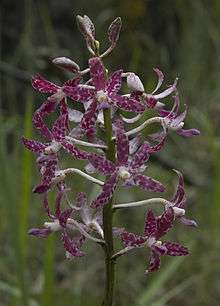Dipodium variegatum
Dipodium variegatum, commonly known as the slender hyacinth-orchid,[2] or blotched hyacinth-orchid,[3] is a leafless mycoheterotrophic orchid that is endemic to south-eastern Australia. It forms mycorrhizal relationships with fungi of the genus Russula.
| Slender hyacinth orchid | |
|---|---|
 | |
| Dipodium variegatum in Meroo National Park | |
| Scientific classification | |
| Kingdom: | Plantae |
| Clade: | Tracheophytes |
| Clade: | Angiosperms |
| Clade: | Monocots |
| Order: | Asparagales |
| Family: | Orchidaceae |
| Subfamily: | Epidendroideae |
| Genus: | Dipodium |
| Species: | D. variegatum |
| Binomial name | |
| Dipodium variegatum | |
Description
Dipodium variegatum is a leafless, mycoheterotrophic orchid and for most of the year, plants are dormant and have no above-ground presence. Below the ground lie fleshy roots and there are leaf-like, sharply pointed, overlapphing bracts at the base of the plant and sometimes protruding above the ground. Between two and fifty flowers are arrange on an unbranched flowering stem 15–60 cm (6–20 in) tall. The flowers are fleshy and cream-coloured to light pink with maroon blotches. The sepals and petals are 11–15 mm (0.43–0.59 in) long and 3–5 mm (0.12–0.20 in) wide and slightly turned backwards. The labellum is 6–15 mm (0.2–0.6 in) long and mauve to maroon. There are two diverging linear, hairy keels near the base of the labellum and a band of mauve hairs about 1 mm (0.04 in) long along its midline.[4][3] A form with sepals and petals that are completely dark maroon occurs in some parts of its distribution.[2]
This species is similar to D. roseum but that species has converging keels on the labellum and lacks the dense patch of tangled hairs near the tip of the labellum of D. variegatum.[3]
Taxonomy
Dipodium variegatum was first formally described in 1987 by Australian botanists Mark Clements and David Jones and the description was published in Proceedings of the Royal Society of Queensland. The type specimen was collected beside the Pacific Highway in Beenleigh, Queensland.[5] The specific epithet (variegatum) is a Latin word meaning "of different sorts, particularly colors".[6]
Distribution and habitat
Dipodium variegatum occurs in eastern parts of Queensland as far north as the Mount Windsor Tableland west of Daintree National Park and in New South Wales as far west as Temora. In Victoria it is only found in the far east. It grows in a wide range of habitats from heath to wet forests.[4]
Ecology
Recovered DNA shows that this orchid forms mycorrhizal associations with Russula solaris and R. occidentalis, in keeping with the observation that many members of the genus form relationships with fungi of the family Russulaceae.[7] The orchid has been observed to occur in close proximity to Eucalyptus species and it is thought that a relationship exists with these trees through this mycorrhizal association.[8]
Pollination of this species, as for all species in the genus, is by native bees and wasps.[2]
Conservation
The species is listed as "rare" on the Victorian Department of Environment and Primary Industries advisory list of rare or threatened plants in Victoria.[9]
Cultivation
No leafless species of Dipodium has been sustained in cultivation due to the inability to replicate its association with mycorrhizal fungi in a horticultural context.[2]
References
- "Dipodium variegatum". World Checklist of Selected Plant Families (WCSP). Royal Botanic Gardens, Kew.
- Jones, David L. (2006). A complete guide to native orchids of Australia including the island territories. Frenchs Forest, N.S.W.: New Holland. p. 273. ISBN 9781877069123.
- Jeanes, Jeff. "Dipodium variegatum". Royal Botanic Gardens Victoria. Retrieved 5 February 2019.
- Weston, Peter H. "Dipodium variegatum". Royal Botanic Garden Sydney. Retrieved 5 February 2019.
- "Dipodium variegatum". APNI. Retrieved 5 February 2019.
- Brown, Roland Wilbur (1956). The Composition of Scientific Words. Washington, D.C.: Smithsonian Institution Press. p. 265.
- Dearnaley, John D.W. (2006). "Fungal endophytes in Australian myco-heterotrophic orchids" (PDF). Eighth International Mycological Congress: 167–170. Retrieved 5 February 2019.
- Bougoure, Jeremy J.; Dearnaley, John D.W. (2005). "The fungal endophytes of Dipodium variegatum (Orchidaceae)". Australian Mycologist. 24 (1).
- "Threatened species advisory lists". Department of Environment and Primary Industries. Retrieved 23 January 2014.
External links
